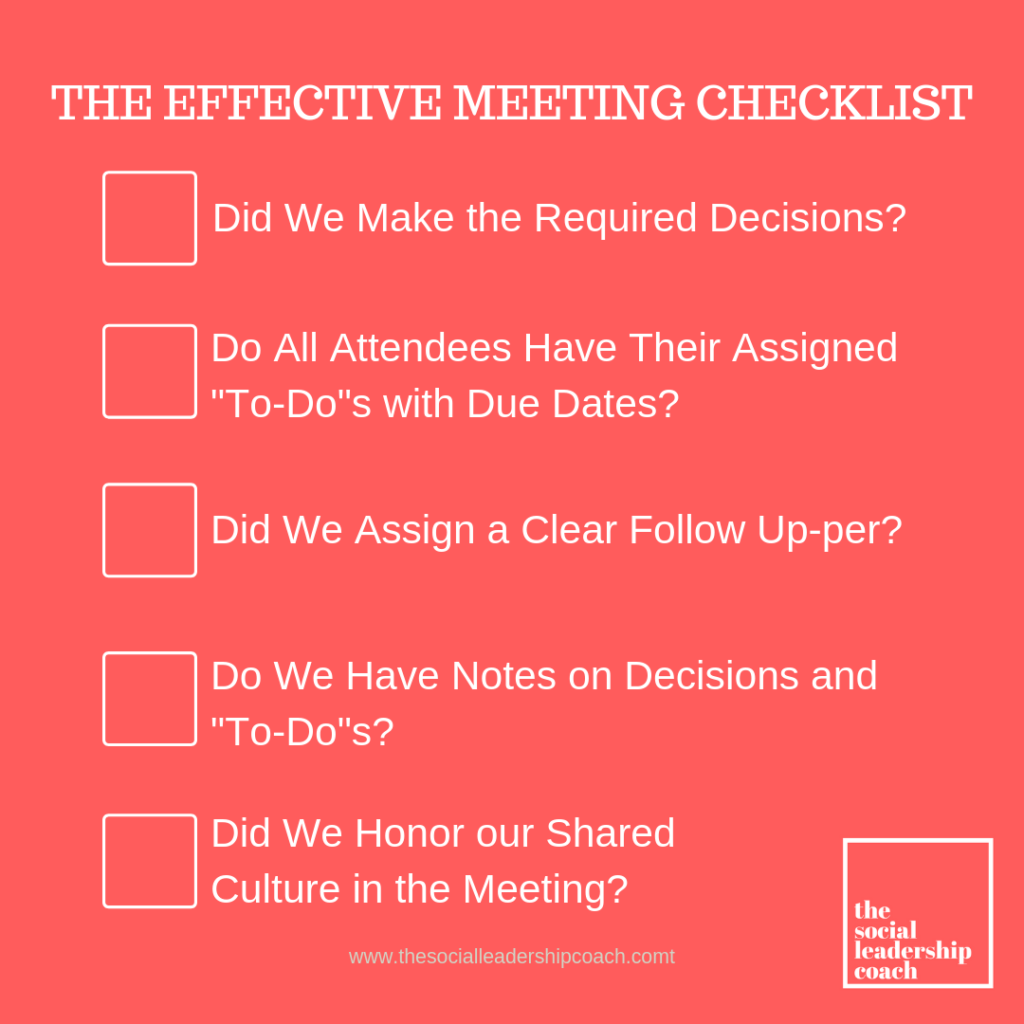This post is also available in:
 Spanish
Spanish
Here are 2 basic truths about me: I love checklists and I hate useless meetings. So, I am combining them to create my Checklist for Effective Meetings.
What is a Useful Meeting?
In this era of information overload, it seems many of us spend our day running from meeting to meeting. Many of these meetings are unnecessary. Useful meetings usually serve any of these purposes:
Make Decisions
Sometimes you need to meet to make joint decisions, considering various arguments and scenarios.
Move Projects (Tasks) Forward
Sometimes brainstorming meetings are required to understand an initiative and break it down into steps. 2 heads are better than 1, right?
Nurture Shared Culture
Every group has a shared (organizational) culture – it’s common values and desired way of doing things. An effective meeting bolsters a healthy bond between attendees and makes that shared culture stronger.
The Checklist for Effective Meetings

Did We Make the Required Decisions?
This one is pretty straightforward. Were all decision points discussed? Were all key pending decisions taken? Did you leave nothing on the table?
Do All Attendees Have Their Assigned “To-Do”s with Due Dates?
Sometimes people in meetings give a lot of ideas for tasks without defining the “who” or “when”. Other times, a few people volunteer for lots of things while others don’t. In an effective meeting, tasks are distributed appropriately. They also include due dates. Everyone should leave a meeting know what they have to do next.
Did We Assign a Clear Follow Up-per?
Follow up is another weak link in typical meetings. You should define a follow up-per at the end of the meeting. This is an attendee who will ensure that people report on their assigned “to-do”s and monitor progress. I normally advocate that the meeting’s note taker take on this role.
Do We Have Notes on Decisions and “To-Do”s?
Many meetings seem to just repeat themselves over and over, with limited progress. This may be due to inadequate note taking. Most meetings don’t have notes and some have minutes that go into such detail that no one reads them. Thus, people keep calling unnecessary meetings to discuss the same things.
An effective meeting has an assigned note taker to document decisions and the action plan (“to-do’s). These are then promptly shared with all attendees and other key stakeholders.
Did We Honor our Shared Culture in the Meeting?
This may be the most important item on our checklist. Did you conduct the meeting according to your shared culture? Do the attendees feel that this meeting nurtured that culture? Do they feel more bonded? If not, what can you do differently next time?
How to Use this Checklist
The great thing about checklists is that they give you a simple guide of what the end result should be. This, in turn, drives your plan. Therefore, this Effective Meeting Checklist helps you prepare for the meeting as well as evaluate it at the end.
I recommend you go through the checklist with all the attendees at the end of the meeting. This ensures you don’t forget anything and also teaches your team how to prepare for future effective meetings.
Enjoyed this Article?
Please comment and share this article with your network using the social media buttons below. You can also check out other articles in my blog. Don’t forget to subscribe to this site for exclusive offers and content. I respect my subscribers and their privacy. Thanks!







Leave a Reply
Your email is safe with us.